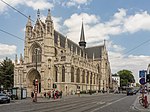Jewish Museum of Belgium shooting

On the afternoon of 24 May 2014, a gunman opened fire at the Jewish Museum of Belgium in Brussels, killing four people. Three of them, an Israeli couple on holiday and a French woman, died at the scene. The fourth victim, a Belgian employee of the museum, was taken to the hospital but died of his injuries on 6 June. A little less than a week later, on 30 May 2014, a suspect was arrested in the French city of Marseille in connection with the shooting. The suspect was Mehdi Nemmouche, a 29-year-old French national of Algerian origin. A second suspect, Nacer Bendrer, was identified and arrested later. Prior to the shooting, Nemmouche had already spent time in French prisons, where he became involved in radical Islam. After his imprisonment, he also spent more than a year in Syria. It is also in prison where he met Bendrer, who was suspected of having supplied Nemmouche with the weapons used in the attack. Investigators identified a third suspect as well, but the charges against the third suspect were later dismissed due to the evidence against him being considered too weak. Nemmouche and Bendrer were formally indicted in April 2018, and tried before the court of assizes of Brussels in early 2019. After two months of trial hearings, a verdict was rendered: Nemmouche was found guilty of having committed the attack, whilst Bendrer was found guilty of being the co-author of the attack by having supplied Nemmouche with the weapons used in the attack. The theory that Nemmouche was framed by foreign intelligence officials, put forward by Nemmouche's defence, was rejected. Subsequently, Nemmouche was sentenced to life imprisonment whilst Bendrer was sentenced to 15 years of imprisonment. Both were later also sentenced to pay close to one million euro in damages to the victims' next of kin.
Excerpt from the Wikipedia article Jewish Museum of Belgium shooting (License: CC BY-SA 3.0, Authors, Images).Jewish Museum of Belgium shooting
Rue des Minimes - Minimenstraat, City of Brussels Pentagon (Brussels)
Geographical coordinates (GPS) Address Phone number Website Nearby Places Show on map
Geographical coordinates (GPS)
| Latitude | Longitude |
|---|---|
| N 50.8408 ° | E 4.3534 ° |
Address
Musée Juif de Belgique - Joods Museum van België
Rue des Minimes - Minimenstraat 21
1000 City of Brussels, Pentagon (Brussels)
Belgium
Open on Google Maps











